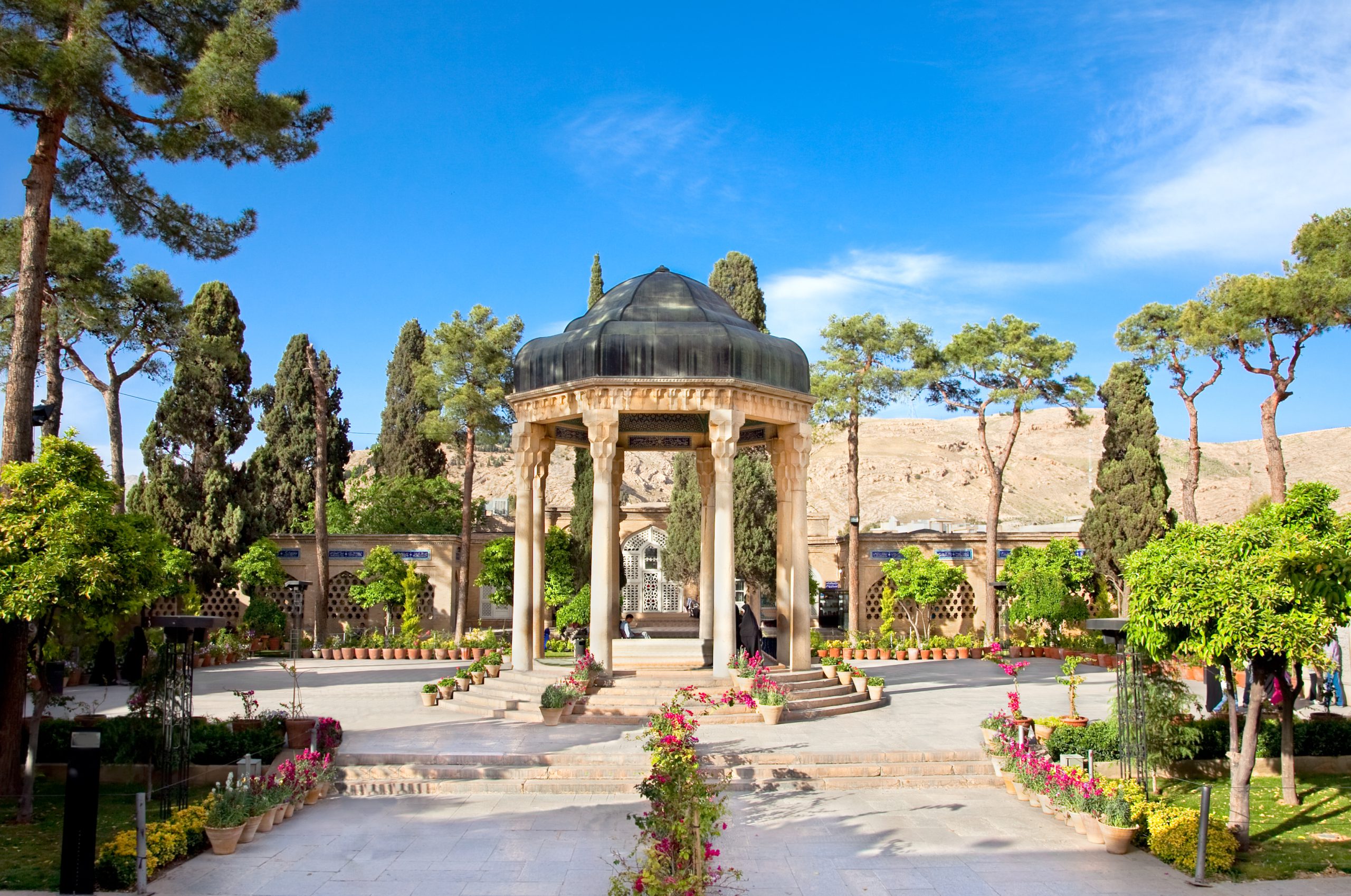
Tomb of Hafez Shirazi | Hafezieh
“Don’t sit on my soil without wine and without a musician So that from your aroma I can rise dancing from the soil…” Hafez
If one of the things Iran is known for is its rich literature, Hafez is probably half the reason why! As if overflown with all the symbolic and sublime spirit of his verses, the Tomb of Hafez (also known as Hāfezieh) fills you up with an aura of peace, romance, and poetry. As one of the most popular attractions among Iranians, the place where the celebrated poet resting there is one reason why the City of Shiraz is known as the city of rose gardens and poets. Stay with me to find out how the greatness of Hafez’s poetry and worldview, the architectural beauty of his mausoleum, and the charm of the garden where it is located have created strong ties with Iranian culture.

Hafez Tomb on a Rainy Day
Why Visit the Tomb of Hafez?
- Hafezieh is one of Iran’s most popular attractions.
- The tomb of Iran’s most well-known poet is there.
- It is one of the best places to get to know Persian culture.
- It features gorgeous architecture.
- The garden where it is located is a popular charm of the city.
- Symbols of Persian spirituality are found in the Tomb of Hafez.
- It is one of the most romantic spots in Iran.
The Shakespeare of Iran
Born in Shiraz in the 14th century, Hafez grew up to become a master of Ghazal (Persian sonnet), Iran’s most celebrated poet, and a leading icon in Persian culture. And to call Hafez the Shakespeare of Iran in fact wouldn’t do justice to Hafez’s unbelievable popularity among Iranians and non-Iranians. If every Englishman keeps a book of Shakespeare at home, reads Shakespeare every Christmas Eve, knows at least a couple of his verses, and travels a long distance just to visit his tomb, Shakespeare would be the fellow of Hafez. But, to a Persian, Hafez is beyond a poet! The 14th-centuryth century man is a man of all ages! A man present in the heart of Persian culture, in every Persian home, and lovely Persian festivals, especially Yalda Night! His poems and his philosophy have also traveled across the world and found admirers like Goethe, Emerson, Pushkin, Turgenev, Carlyle, and Garcia Loca.
Girl in the Tomb of Hafez, Hafezieh
Hafez, the Nonconformist and Critic
Hafez knew the Holy Quran by heart, and the scripture was his inspirational muse. Characterizing himself as a ‘Rend’- a sly, a rebel, a thief of love, and a nonconformist who is upright inside- in his poetry, he strongly criticized religious extremism and hypocrisy. He was unorthodox in his religious beliefs and safeguarded a true version of Islam in poems of musical lyricism, easy spontaneity, and spiritual ambiance. This makes Hafez even more popular among Iranians.
Tomb of Hafez @mohammadreza abdollahi
Hafez in Modern Persia
You can hear reverberations of Hafez’s contributions to Persian culture in many aspects of contemporary Iran. The crowd of pilgrims who visit his resting place year in and year out doesn’t go there only for the beauty and peace of the site. The poet’s popularity among Iranians of all ages and backgrounds is also a key factor. A source of national unity and pride, he still attracts Iranian hearts to his poems beyond a gap in history, cultural changes, foreign invasions, and revolutions.
For Persians, Hafez’s poems are a source of hope, wisdom, and spiritual energy. There is no Persian who can’t recite at least one of his verses. The book of his poems, ‘Divan of Hafez’, is also tied to Persian culture. Besides the Quran, you can also find a book of Hafez in every Iranian house. The book is a must-have in Persian celebrations like Nowruz and Yalda Night. Fortunetelling by randomly opening a book of Hafez is also a common practice in the country, especially in the garden area of the Tomb of Hafez. National Hafez Day on the 22nd of October is also celebrated in Iran.

Book of Hafez on Yalda Night Table
History of the Tomb of Hafez
Hafez was buried in the Musalla Garden he profusely admired in his poetry. The first memorial structure was built over his tomb in the 15th century (65 years after his death). After that, kings, governors, and literature lovers of different periods have been paying homage to Hafez by renovating the monument. The structure had been undergoing reconstructions, destructions, and constructions during the Timurid, Safavid, Afsharid, Zand, and Qajar periods until the current pavilion was built in 1935 under the reign of Reza Shah Pahlavi. Using the architectural elements of the Zandieh Period, the French architect and archeologist, André Godard, gave the mausoleum of Hafez its present look.
The Architecture of the Tomb of Hafez
The tomb, the gardens, and the buildings surrounding it are all special. Inspired by Zandieh architecture, the tomb of Hafez itself is a pavilion built on a platform encircled by 5 steps. A dome-like structure that’s supported by eight 10-meter-high columns shelters it. Standing under the dome, you can see the tasteful decorations of the underside. It features arabesque tilework and calligraphic verses of the poems of Hafez on the corner.
The site includes a memorial hall that divides Hafezieh into the northern and southern sections with a long verandah of 20 columns. You can see elements of the Achaemenid and Zandieh architecture in this hall. The other charms of the place include the gorgeous garden of orange trees and flower beds. You’ll also find a library of 10,000 volumes dedicated to Hafez Studies.

Top View of the Tomb of Hafez
The Hidden Symbols of Hafezieh
As is customary in the architecture of many Islamic shrines, the tomb of Hafez showcases symbols of paradise and the stages of spiritual elevation. The first symbol is in how the tomb is hidden from the outside world. Hidden behind the stairs, the tomb stands for the concealed state of the secrets of the heavens and Hafez’s spirituality. The southern section is the mundane world which one must pass to reach the 9 skies mentioned in Persian literature (the 9 steps). The steps then lead to Paradise (the tomb itself). The northern part, symbolizing the kingdom of heaven, is surrounded by 8 entrances that stand for the 8 gates of paradise.
The dome itself symbolizes heaven. The motif of the number ‘eight’, like in the number of its columns and in the shape of the structures, both refers to the 8 paradisal pleasures and the century in which Hafez lived. The outer side of the dome that looks like a Sufi’s hat is indicative of the circular dome of the sky. The designs of cypress trees and peacocks on the walls of Hafezieh are all indicative of eternal life.

The Fortune-telling Hafez
The tradition of Fal-e Hafez, fortune telling by opening the Divan of Hafez, is a popular practice in Iran. Persians close their eyes, clasp their hands together, ask the poet to show them their fortune, and open a page. Today, the fortune-telling tradition has taken an even more delightful form. Walking on the street in front of the tomb (or sometimes in other parts of the town) you find a boy with a little bird and a box of cards in his hands. Just close your eyes, focus on the thing you like to be enlightened about, and call Hafez nice names. The card the cute birdie picks for you tells you your fortune.

Iranian Girl Reading Book of Hafez at Tomb of Hafez
What to Do in the Tomb of Hafez
There are many things you can enjoy doing in the Tomb of Hafez. Make a wish and throw a coin in the large pool beside the tomb. Or enjoy the traditional refreshments at the tea house or the ice cream parlor found there. Shopping for gorgeous Iranian handicrafts in gift shops is also a must-do. Finding Persians reading a Divan of Hafez on a corner is a common sight there. You too can get a translated version of the book and enjoy the wisdom and beauty of the poems.
More Bout the Tomb of Hafez
Visit Hours
Spring and Summer 7:30 a.m. to 10:30 p.m.
Fall and winter: 8:00 a.m. to 9:30 p.m.
Visit Days
All days except some public holidays.
The Nearby Attractions
Near the Tomb of Hafez, you can enjoy the peace of the historical Jahan Nama Garden, check out the spiritual atmosphere of Ali Ibn Hamzeh Holy Shrine, or enjoy some time at the popular Qur’an Gate and visit the Tomb of Khaju Kermani.
Where to Eat Near the Tomb of Hafez
Dashakol Traditional restaurant
Joulep Café restaurant
Taghcheh Café Restaurant
Seray-e Mehr
Della Steakhouse
Like to pay a visit to Hafezieh?
Then join our Persepolis, Naqsh-e Rostam & Tomb of Hafez excursion tour or one of our multi-day Cultural Tours.










